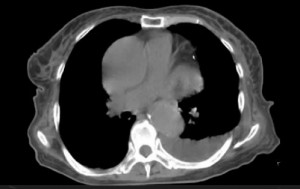The omentum is a big fatty formation that can be found hanging off the middle of the colon as also draping inside the abdomen, over the intestines. There are no studies that explain the reason for its evolution; neither does it have any functionality. It is found to reach out to all the organs present in the abdomen and tends to attach itself and drape over regions that are affected by inflammation.
There are some who argue that it performs the function of a bandage in case of a rupture of the intestines or bad infection, thereby limiting the transfer of infection to other organs. The omentum has a number of small blood vessels and hence it plays an important part in the development of ovarian cancer. Cancer cells that break away from the ovaries usually tend to implant themselves in the omentum and grow there. This process is known as omental metastasis.
Omentum cancer caused due to ovarian cancer, tends to begin in the ovaries, which are present on each side of the uterus in women. Ovarian cancer is difficult to detect in the early stages, until it has spread to other regions such as the abdomen and omentum. Ovarian cancer detected in the later stages is difficult to and does cause fatalities.

Symptoms of omentum cancer
Omentum cancer is predominantly caused due to ovarian cancer and hence tends to show signs and symptoms that are similar to those of ovarian cancer.
Some of the symptoms of omentum cancer are listed below:
- Pressure, bloating, swelling or fullness of the abdomen
- Indigestion that is persistent, nausea or gas
- Pain or discomfort in the pelvic region
- Bowel habits alterations that include constipation
- Unexplained appetite loss, or feeling of rapid satiety
- Alterations in bladder habits, such as increases in the urge to urinate frequently
- The clothes may become tighter around the waist, which may be caused due to increase in abdominal girth.
- Pain in the lower back
- Lack of energy or fatigue that persists
Types of ovarian cancer
Since omentum cancer is usually caused due to ovarian cancer, it is essential to know about the different types of ovarian cancer for effective diagnosis of omentum cancer and prompt treatment.
The different types of ovarian cancer are determined by the kind of cell where the cancer commences. The different types of ovarian cancer that result in omentum cancer are as follows:
- Omentum cancer that is caused due to cancer that commences in the cells which produce eggs: Younger women are generally affected by such ovarian cancers and are known as germ cell tumors.
- Omentum cancer that is caused due to cancer that commences in the cells present outside the ovaries: The cancers start in the filamentous layer of tissue which covers the outer part of the ovaries and are known as epithelial tumors. Most cases of ovarian cancers are epithelial tumors and hence most cases of omentum cancers are epithelial tumors
- Omentum cancer that is caused due to cancer that commences in the cells which produce hormones: The cancers tend to start in the ovarian tissue which is responsible for the production of hormones such as progesterone, estrogen and testosterone. They are known as stromal tumors and cause this third type of ovarian cancer that eventually leads to omentum cancer.
Causes of omentum cancer
The exact reasons for the different types of ovarian cancers are not known. As a rule, cancer starts due to the mutation of normal, healthy cells into abnormal, altered cells. The healthy cells tend to grow and multiply at a uniform rate and die after a definitive time period.
On the other hand, cancer cells tend to grow and multiply at a rapid pace. They also do not die. An accumulation of such cancer cells results in the formation of a mass or tumor.
Cancer cells also tend to separate from their initial origins and spread to other tissues in the body. Such spread of the cancer cells is called metastasis, and metastasis of ovarian cancer cells is what results in omentum cancer.
There are several risk factor that increase the chances of ovarian cancer and thereby the vulnerability to omentum cancer. Some of them include:
- A family history of ovarian cancer or omentum cancer increases the risk to the condition.
- Women who have inherited gene mutations such as breast cancer gene 2 (BRCA2) and breast cancer gene 1 (BRCA1), as well as have a inherited syndrome hereditary nonpolyposis colorectal cancer or HNPCC, are at greater risk to develop ovarian cancers and omentum cancer.
- A personal history of cancers of the colon, rectum, breast, or uterus increases the risk to developing omentum cancer
- Women who have never been pregnant have increased risk to ovarian cancer and omentum cancer
- Ovarian cancer or omentum cancer tends to develop after menopause and the risk increases with age
- Some studies indicate that hormone replacement therapy may increase the risk to ovarian and omentum cancer
Omentum cancer treatment
- Omentum cancer can be treated by surgical removal of the omentum. The accompanying ovarian cancer would also involve treatment that uses surgery for removal of the ovaries and other affected tissues.
- Chemotherapy may be used to intravenously inject drugs that are specifically designed to find and kill the cancer cells. Such drugs may also be directly injected in the abdomen to kill the abnormal cells that cause omentum cancer
Recently mother dignosed omentum cancer
Can anybody give me contact detail of any good cancer specialist.
Thanka